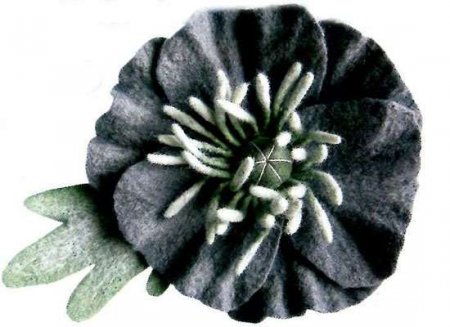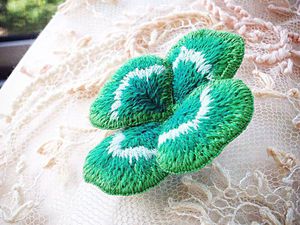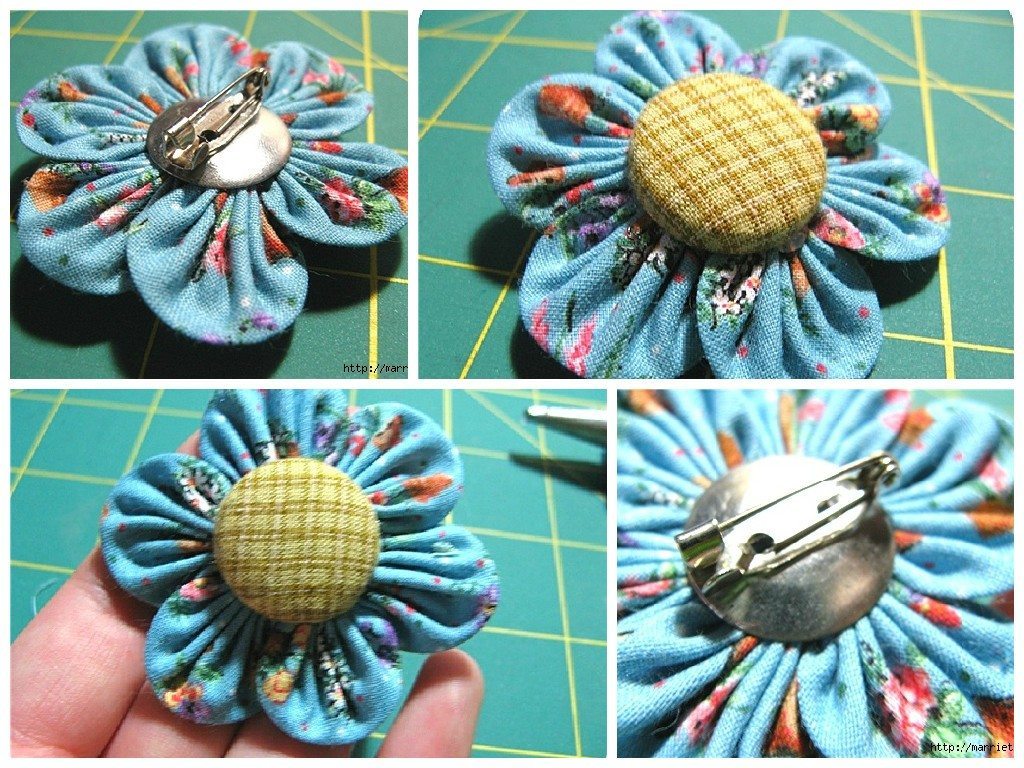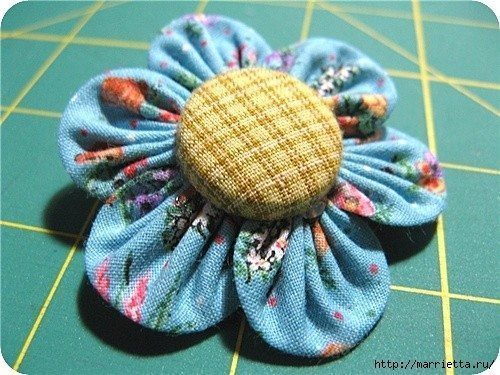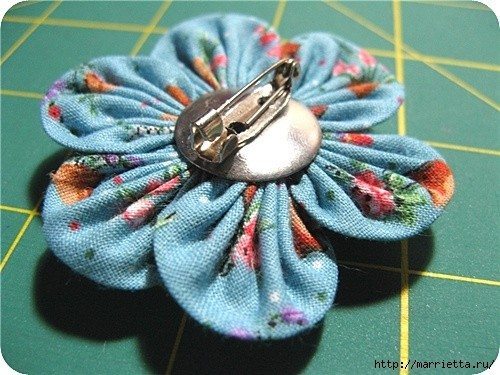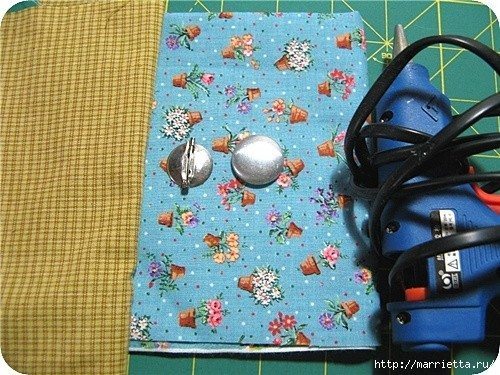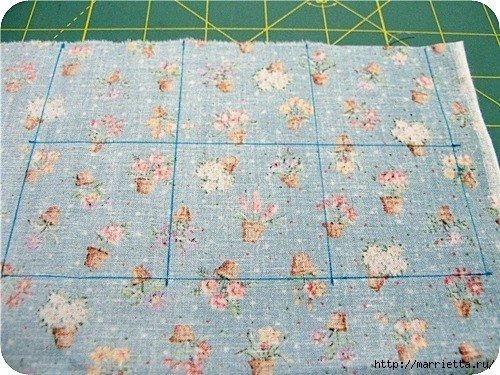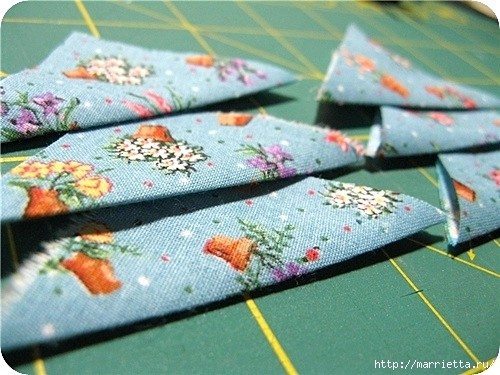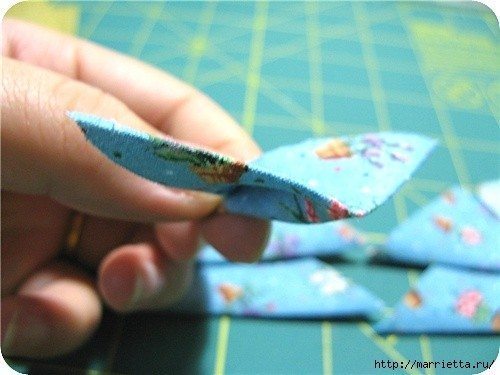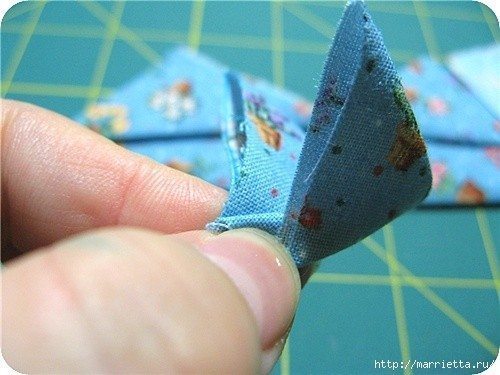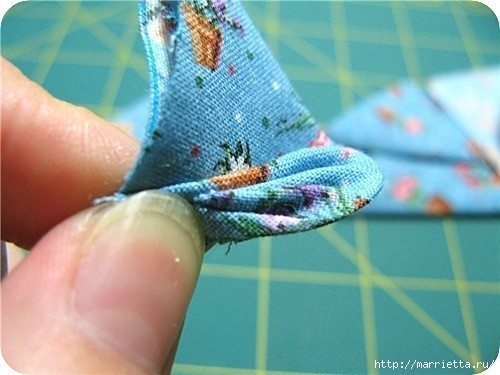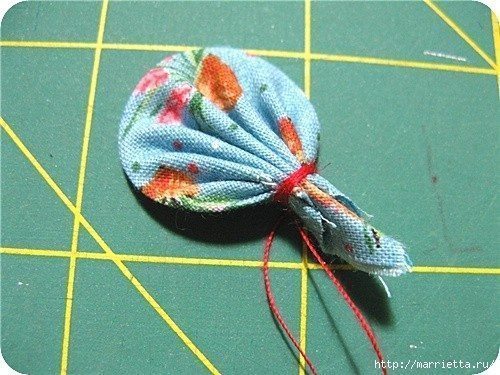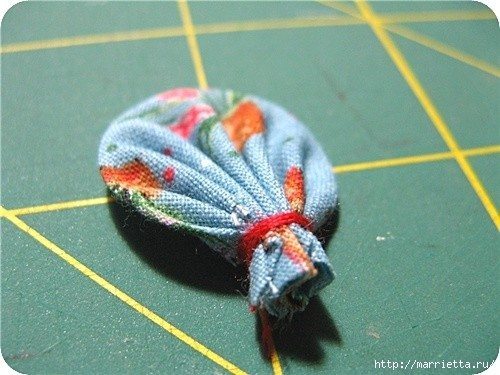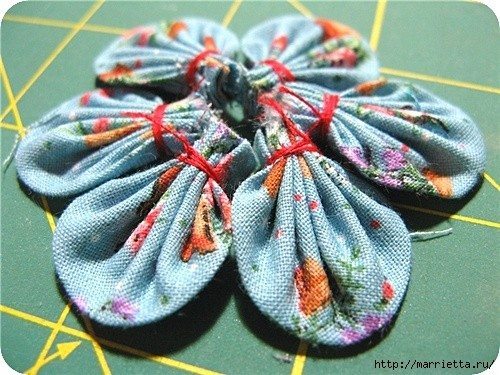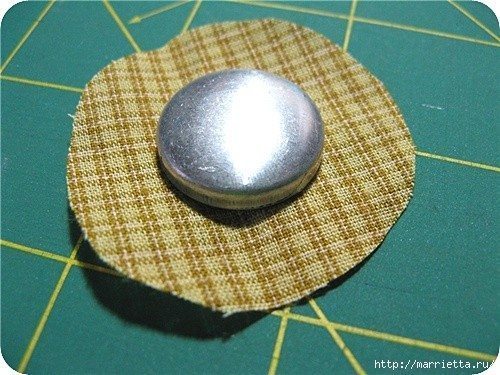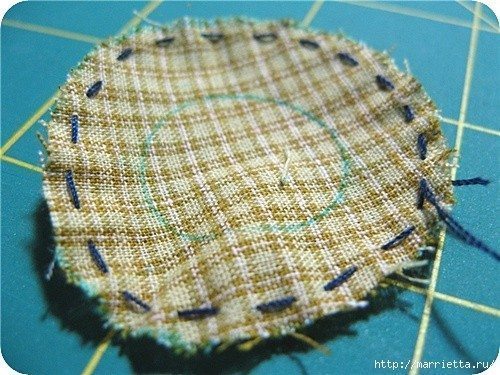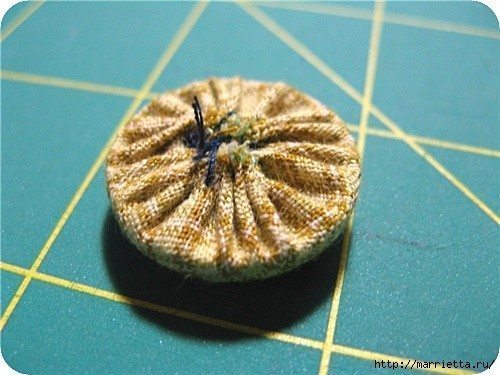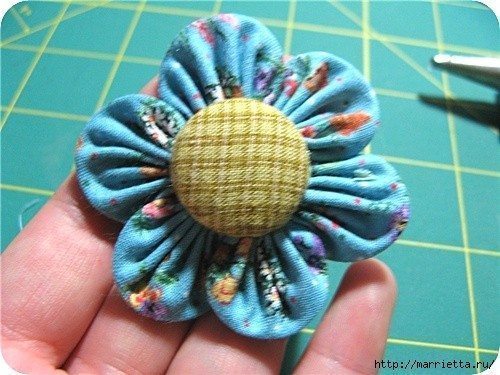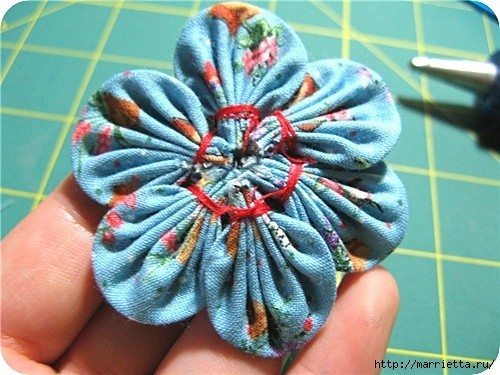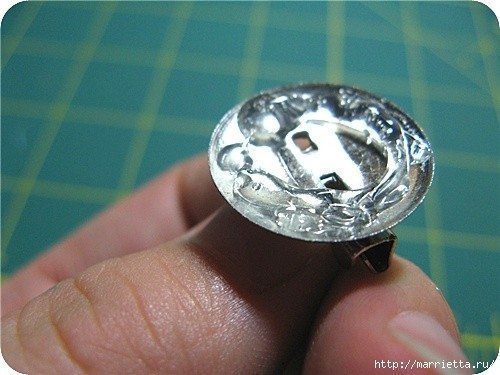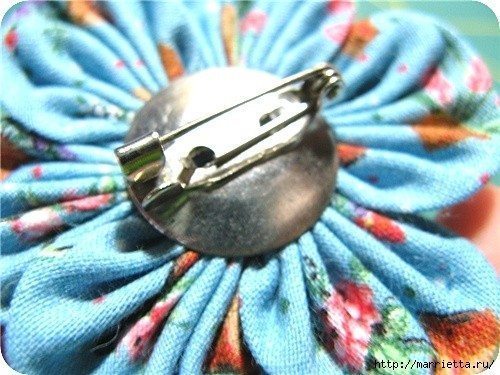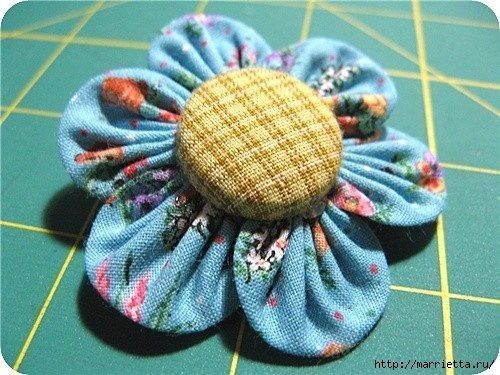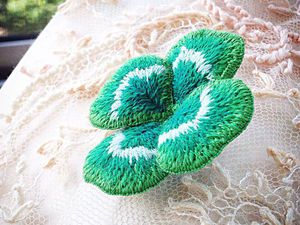
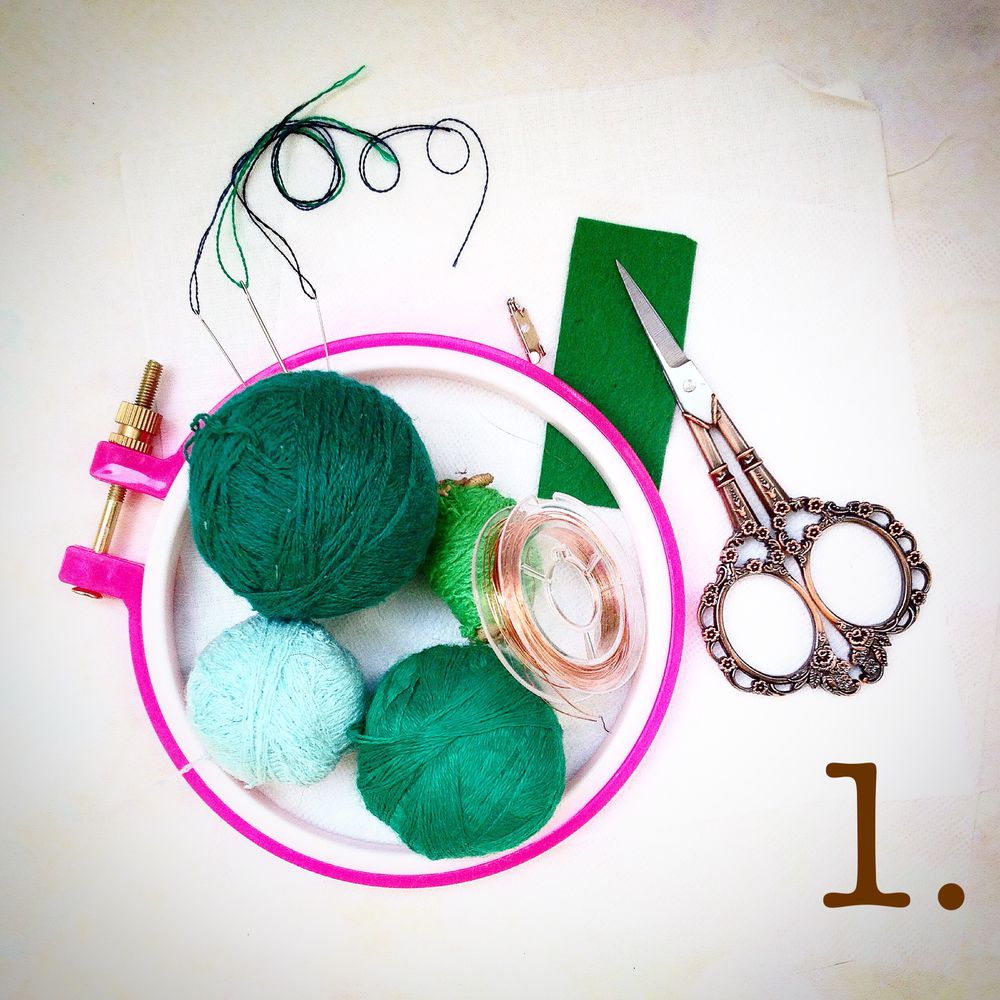
1. The need for the work:
Materials:
– A piece of the base fabric (cotton batiste white for me). You can use any plain weave fabric, thin, with a slight parting of the filaments. The thinner the warp and the weft, and less extendable, the smaller the holes and the whole embroidery is neater and more elegant;
– Thread (my grandmother acrylic 4 colors). If you are new to embroidery, it is better to take the line of the same quality and thickness;
– Copper wire 0,3mm. (. I have a green color, but you can take and conventional, uncoated, as it will be on the wrong side and closed her embroidery will not be seen);
– A piece of green felt thickness of 1 mm 2 area of 1-ruble coin;
– A piece of water-soluble non-woven fabrics of the same size as a piece of the base fabric to be able to fill in the hoop;
– Thread for basting usual (I coil plain white sewing thread);
– The basis for the brooches in the form of pins 15 mm. Or you can use any basis for brooches.
Adaptations:
– Hoop (I have a small 12 cm in diameter);
– Scissors for cutting thread;
– Scissors or clippers to trim the wire;
– Tracing;
– copy paper;
– Needle Embroidery (select based on the thickness of the yarn and fabric);
– Pen or pencil.
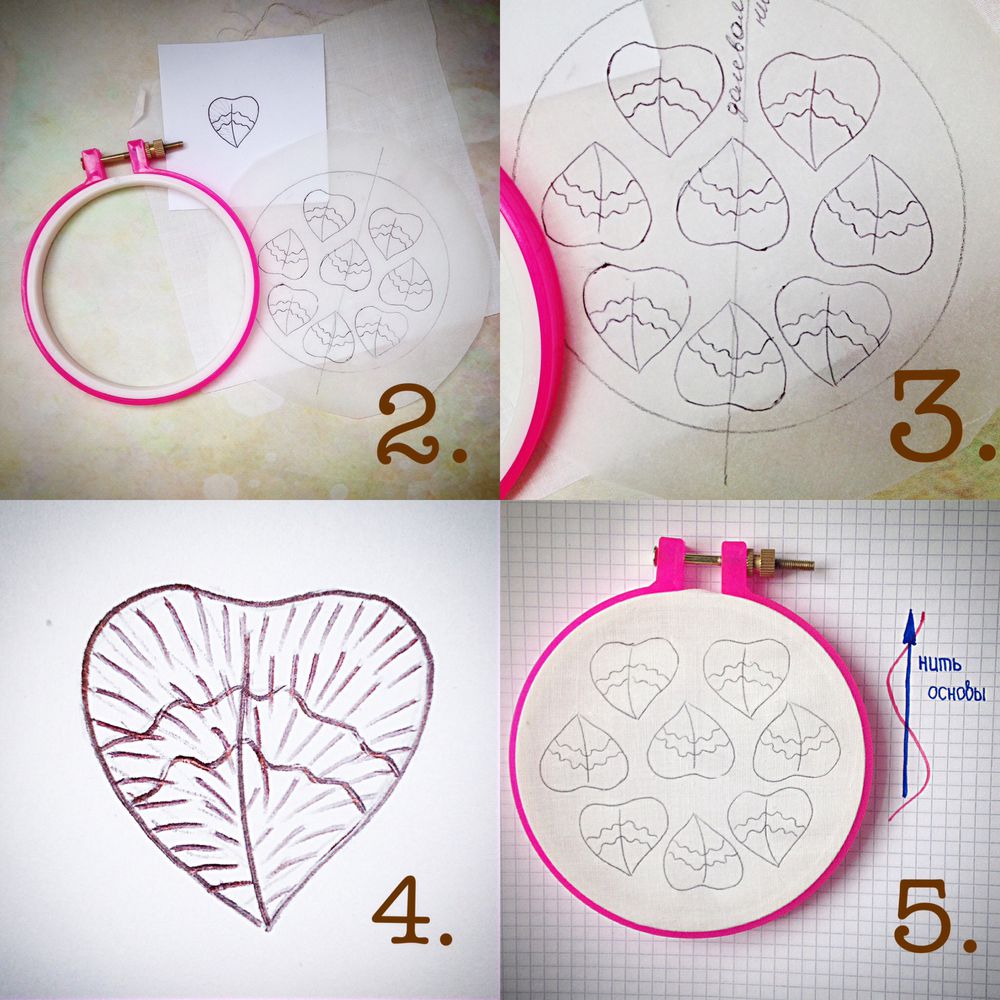
2, 3. Figure. There are no secrets there special. Draw leaves like anyone and anything. I draw on a standard sheet of paper. On tracing paper marks the boundary (obvozhu hoop), designate an equity thread and relative to translate all the leaves in one direction. If the leaves are arranged in a chaotic manner, they will not be the same. Figure embroidery process deforms differently. Clover although this is not critical, the plant must not be perfectly rovnenko.
4. Drawing a leaf. dashed line – this line of embroidery stitches. I imagine them on the fabric does not always draw. Who doubts in the forces – draw.
5. Switch the pattern on the fabric and dressed with fabric in the hoop. I translate using carbon paper. Folding the paper so that the image transferred to and from the front and the reverse side. The hoop dressed with fabric in such a way that there are no distortions of warp yarns of fabric (blue line in the figure is correct, the red is not.)
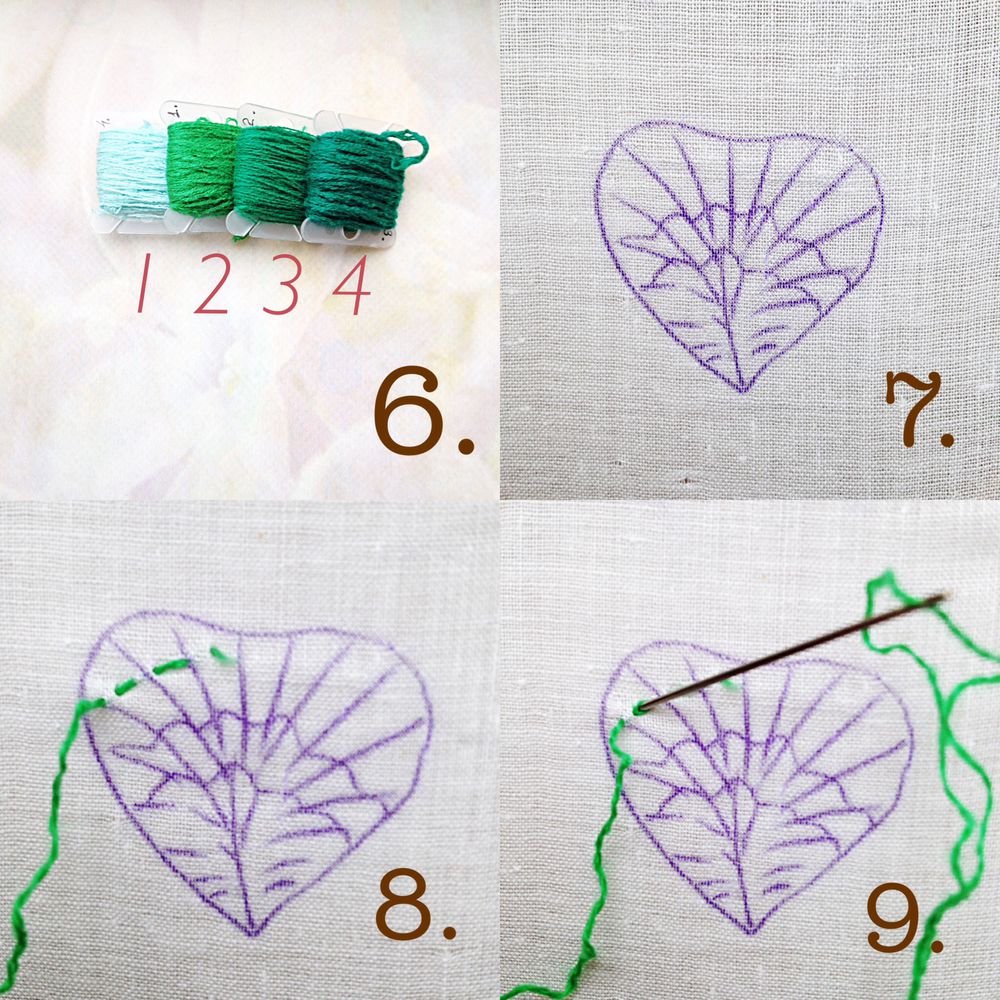
6, 7. Starting to embroider shade number 2.
8. Fix the end of the thread. A few small stitches across the floor of the future.
9. Perform one stitch back, sticking a needle in a thread, as if splitting it. All that now it will be fixed and will not go anywhere.
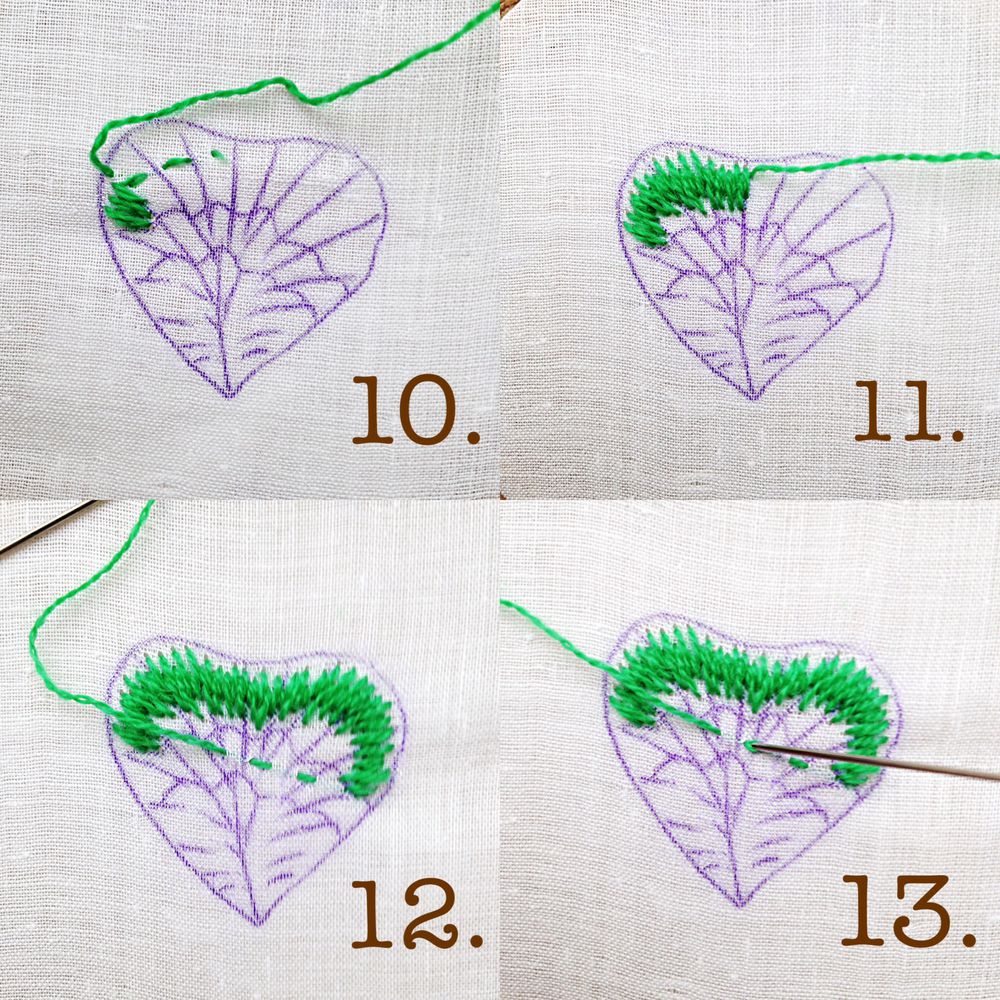
10. Getting flooring laid with stitches of different lengths at different levels. Stitch length not exceeding 7 mm. gaps between the stitches do not need to, they must lie close to each other, but do not “run down” on each other so that the flooring is not Bouguereau. In principle, the gaps can be filled by returning back, but then will turn to the wrong side and the wrong side of the diagonal broach get less accurate. Ideally, it is not necessary to go back at all, then the surface of a two-way turn. The photo shows that the first row of stitches I do not stack exactly to the edge, and departing from it. Full series of stitches will be done later, along with the wire. The distance from the first row to the contour line should not exceed 7 mm in all areas.
11. Continue to embroider the first row.
12 13. Fasten the thread along the same lines as in the beginning, but in reverse order.
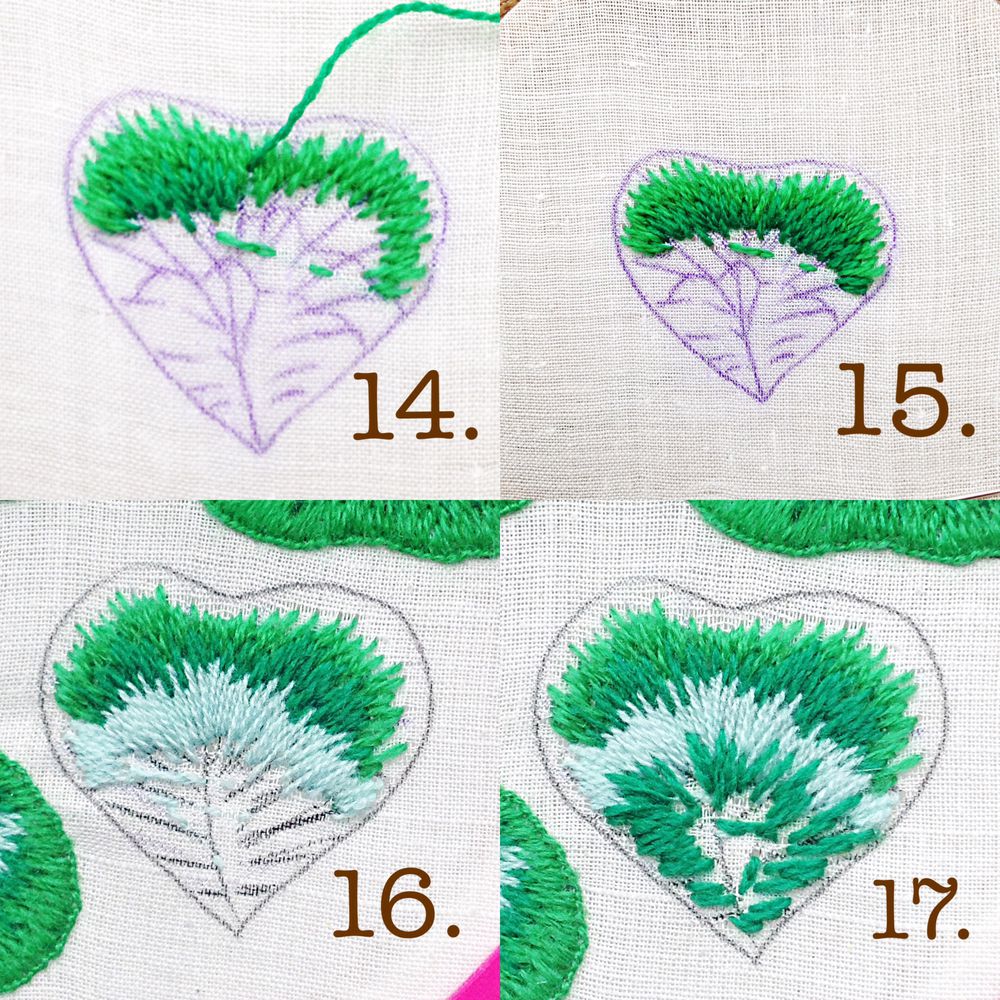
14. Take the thread color number 3 and begin to embroider the second row, second stitch – continuation of the first, that is, you need a needle stick is not the end of the hole, and from the first stitch, and, splitting thread, just going to the stitch. It is a guarantee that there will be holes in the finished embroidery, regardless of the quality of the fabric.
15. The same number of stitches of the second lengths. “Pour” one color to another.
16. The third row execute thread color number 1.
17. Again, take the shade of thread number 3.
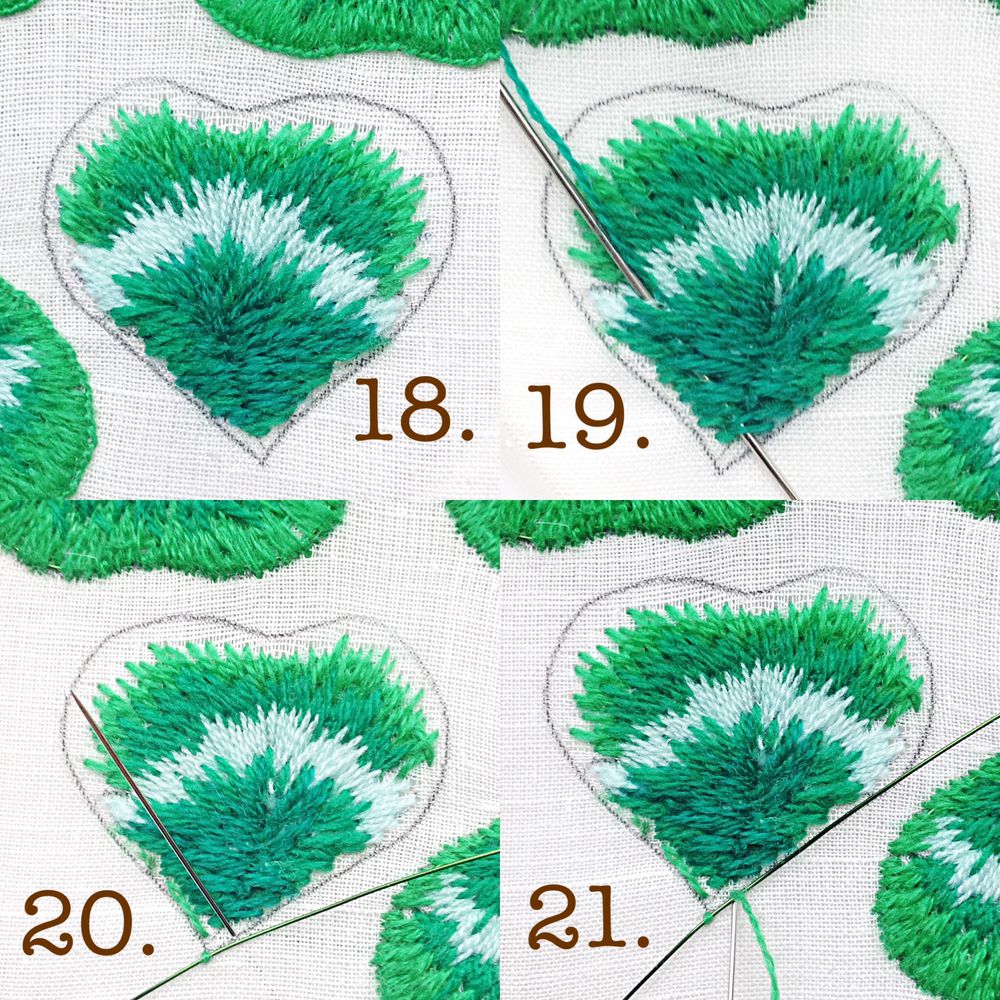
18. Shade number 4 finish embroider leaf.
Shades, their number and location are recommendatory in character. Do so, as required by your imagination, skill and vision of beauty 🙂
19.Pryachem ends of thread on the wrong side under the flooring.
20. Overturn embroidery on the wrong side (pull out of the hoop, and then dressed with a pre, but the wrong side up). Cut the piece of wire. The free ends are too long, you should not do – 2-3 cm is enough.
21. sew thread color number 2 couched stitch technique zero stitch. That is, a needle is stuck there, where pulled out, rounded the wire at the same time. The picture is clear, like. The distance between the stitches can be varied. the stronger the bending, the more stitches. But not more than 6 mm.
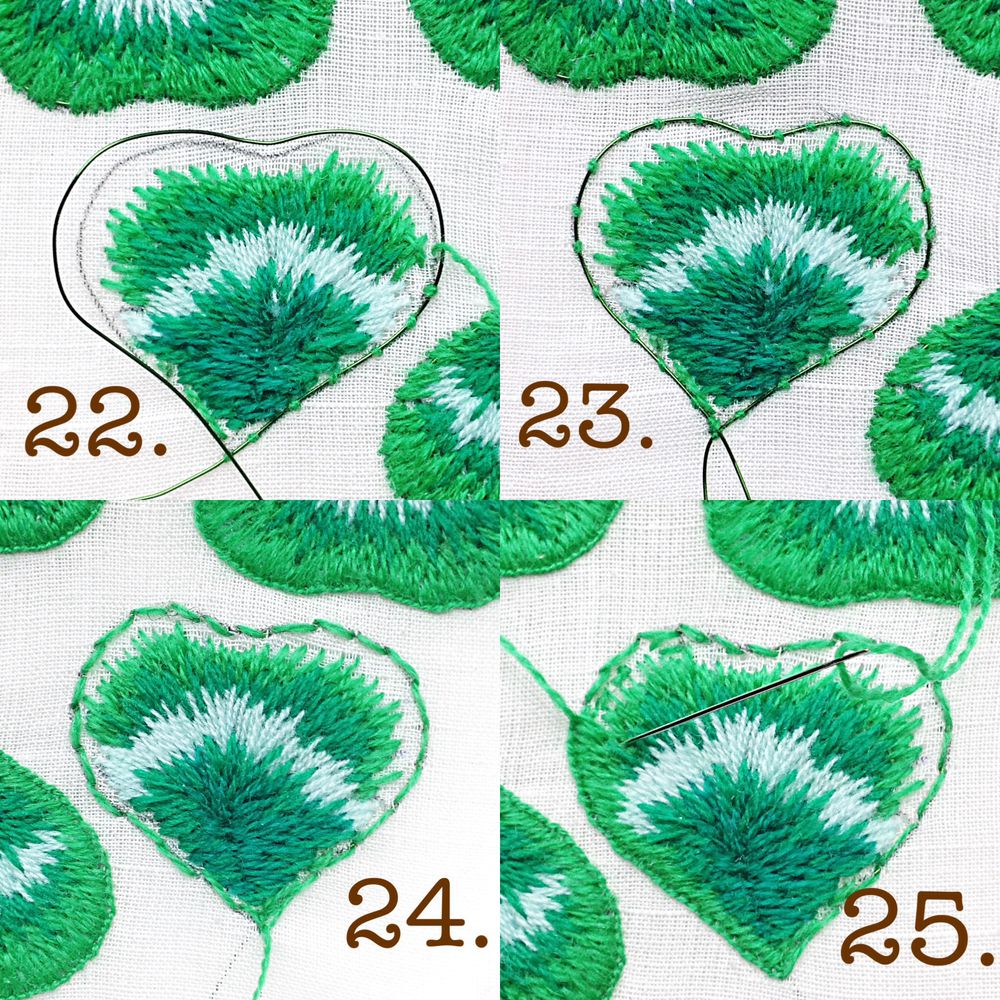
22. The wire should be laid on the contour line, which we have translated and inside out too. Remember? I sew the wire at this stage, when the main embroidery is ready to wire ends do not interfere.
How many saw all do it at the very beginning – to embroidery. Treat the first stitch the edges together with wire and then embroider the center. On the one hand it is clear – embroidery less deformed. But it is not convenient. The wire sticking out – a thread for it cling irritate 🙂 Take your pick.
23. The wire sewn. Threads I was not cut, but simply deduce the front of the embroidery – then come in handy.
24. Type of wire sewn embroidery on the front side.
25, 26. Again turn over embroidery. On the front side. And buttonhole stitches embroider edge of leaf color thread number 2. Technology is the same – to stick a needle in the previous stitch in thread, rather than next to it.
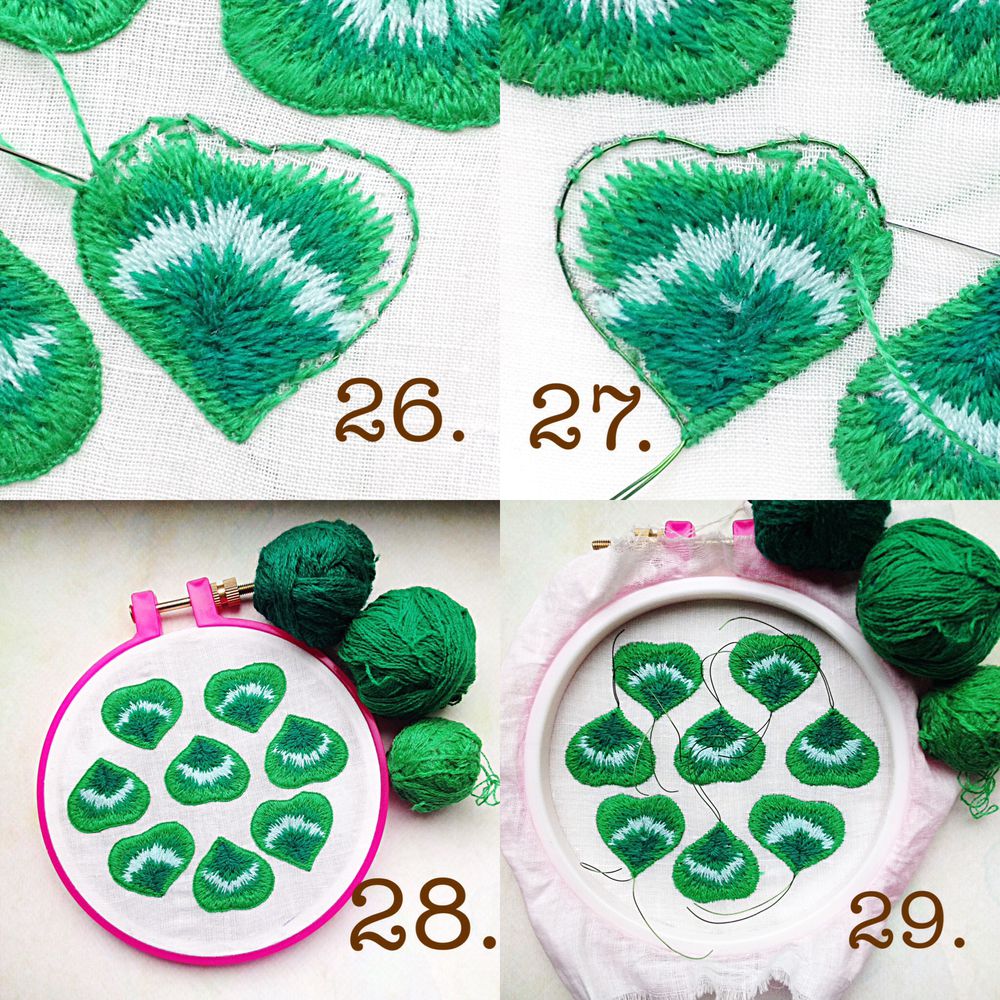
27. On the reverse side the needle comes very close to the wire on the outer edge. In order to get exactly, embroidery turn is not necessarily, the wire is well detectable. Or a needle leading to the center of the leaf on the fabric, and it rests on the wire, make a puncture. The stitches should be laid close to each other. If the gaps are formed, do not worry, later we will close them.
28. The front side of the embroidery with a loop suture treated leaves.
29. Wrong side stitch.
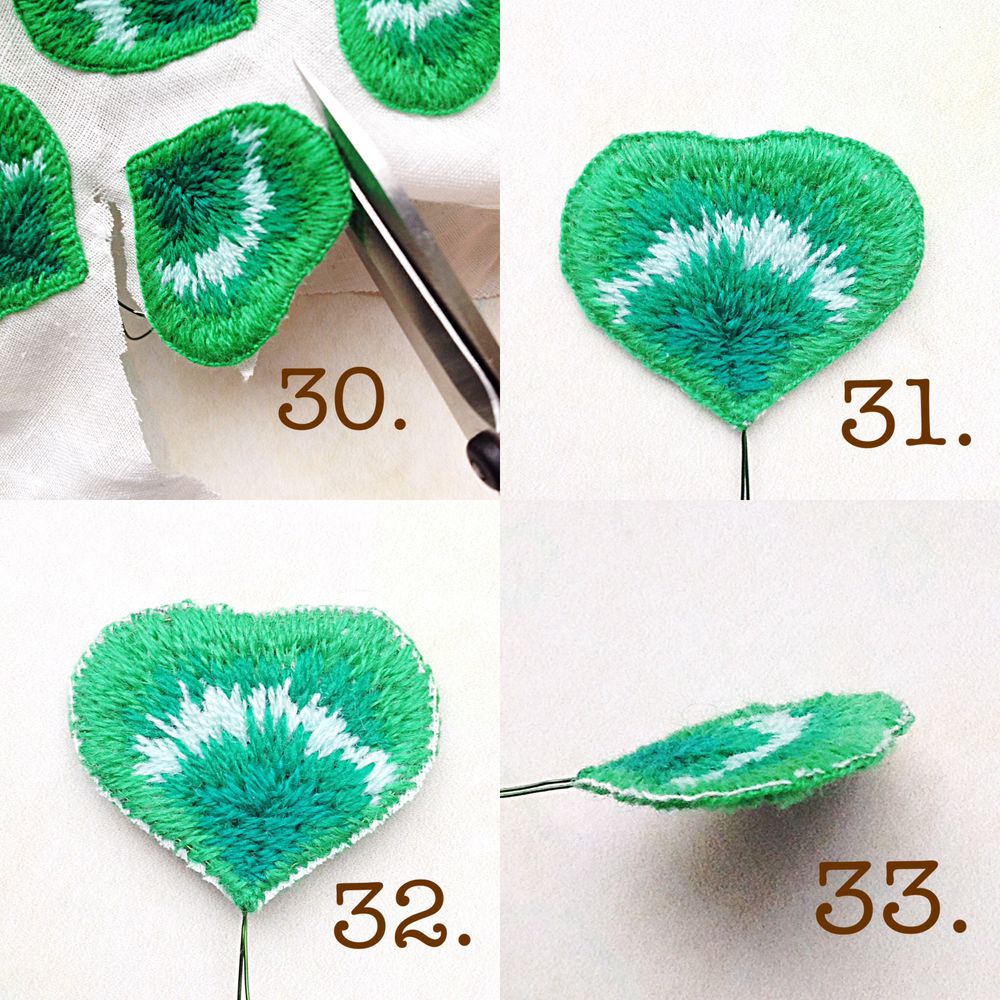
30. Take out the embroidery of the embroidery frame. Small sharp scissors cut out the leaves as close to the pigtail hinge joint. Cut holding embroidery facing up. If you’re on the wrong side of cut 100% damage the thread on the edge. Read Tips If slice the thread, then immediately fall onto nail varnish or glue in place “injury.” I is not never embroidery stabbed.
31. The cut sheet of paper from the front side. Remnants of the base fabric is almost not visible.
32. The cut sheet of paper from the wrong side. Here the base fabric is already very well visible and it looks sloppy.
33. The edge of a leaf. Visible white rim tissue osnovy.Vot stripes from this, we will get rid of using a water-soluble non-woven fabrics.

34. We put in a water-soluble nonwoven hoop. Wire tails skip through the fabric inside out so as not to interfere with work.
35. Regular sewing thread of any color, basting stitches slanting leaf on interlining, that in the course of work will not run away.
36. Baste leaf. View from the inside out.
37, 38. And now again looped stitches of different lengths, thread color number 2 runs along the edge. Fill the gaps, if sinned in the previous step. From the edge of the sheet is not retreat much, ideal to do the very edge of the sheet. If you are going away to recede, the region will be fuzzy, loose and wavy. This effect can also be used, for example, in colors. The end of the thread at the beginning and end of the hide under the floor.
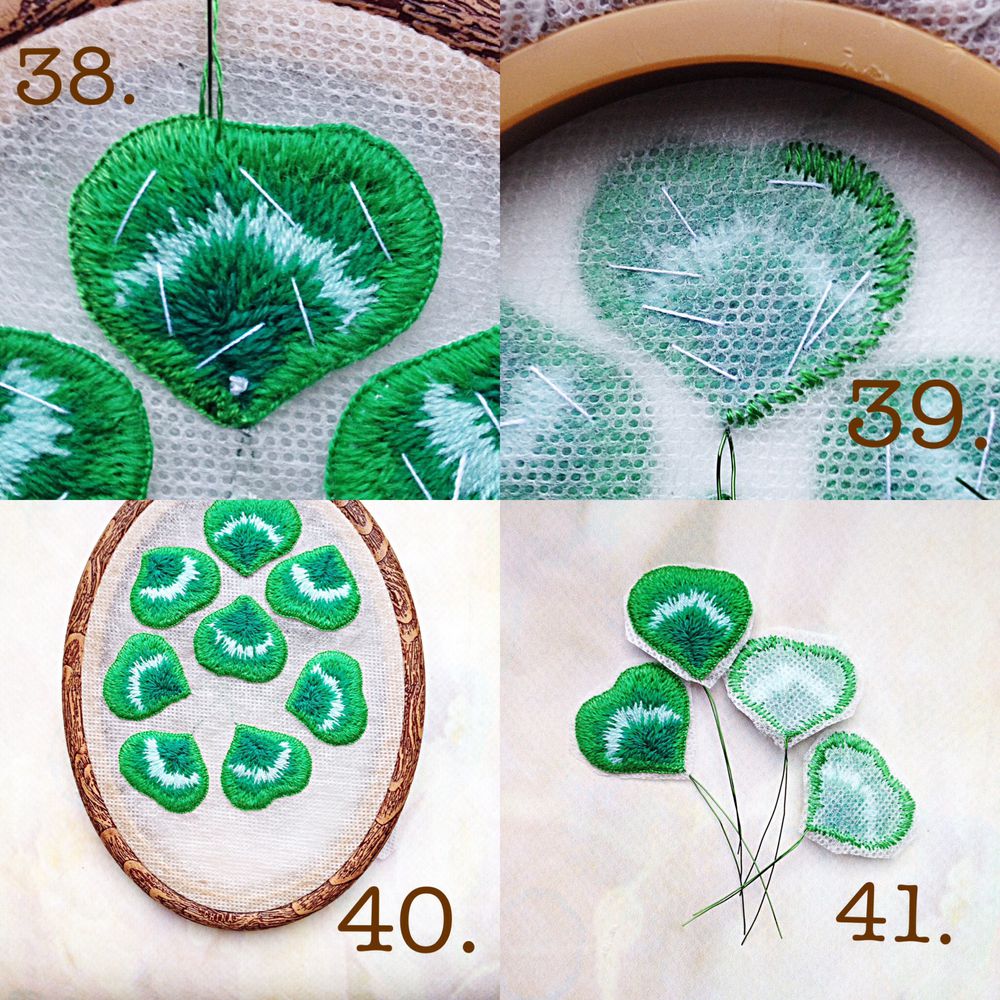
39. View from the wrong side.
40.Vynimaem basting thread leaves.
41.vynimaem of embroidery hoop. Cut leaves. You can not very gently, important not to damage the embroidery.
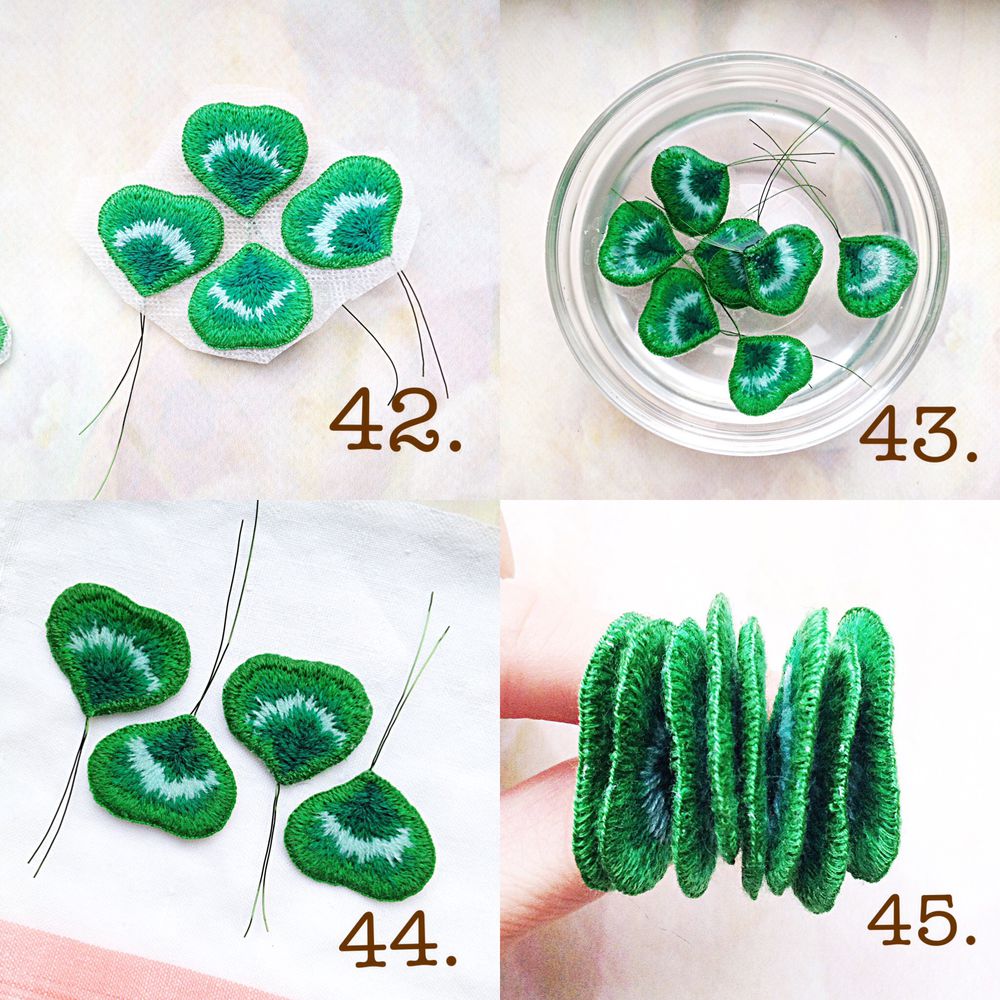
42. If it is absolutely unbearable, or laziness, they can be generally one does not cut, and entirely with the whole piece of nonwoven lowered into the water. All the same, it will dissolve, but I prefer to cut and then spend less time in the tap water.
43. Put the leaves in a bowl of water at room temperature. Fleece can be different, and dissolved over different time. See specifications. I is 2 minutes in a bowl. I then I wash the leaves under running water until complete washout nonwoven.
44. We spread the leaves on a towel or rag, blotted the excess moisture. Dry them. I dry, wrapped in a towel, directly on the battery.
45. The result of applying a water-soluble nonwoven’s such a beautiful, neat edge without a fringe and protruding threads, which is not exactly osypetsya. And interlining nakrahmalivaet little embroidery.
Can I do without it?
Mmozhno!
– If you do not particularly bother with accuracy;
– If the edges of negligence fits into the image, character and style of your product;
– It is possible to select as the base fabric is not white, and green, and then the warp is hardly seen from the end;
– Paint over the contour of the base fabric marker or paint the color of the thread edge. Then, too, the fabric will not be seen;
– Walk along the edge of a loop seam without interlining, just holding leaf in hand. In this case, the edge will be more loose and not very smooth, but as an option is well suited.
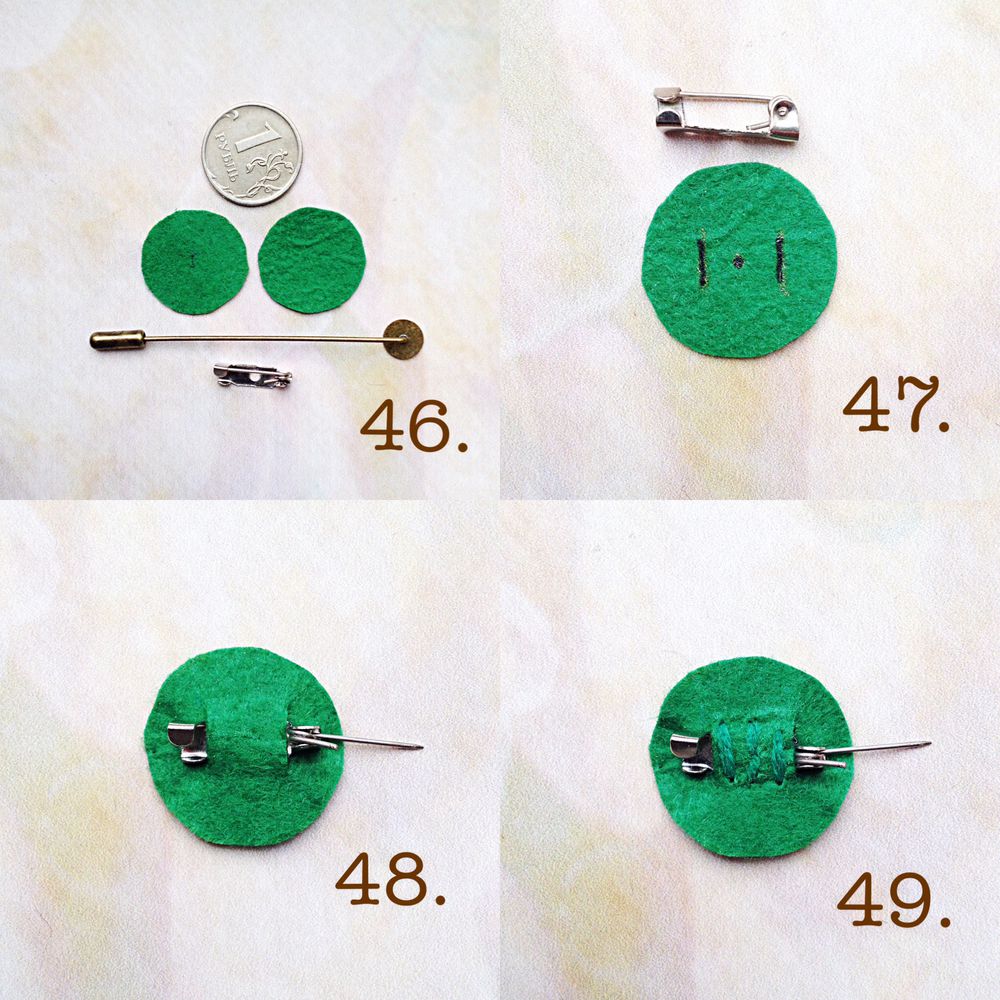
46. Cut the green felt two thin slices the size of a 1-ruble coin. It may be any fastener in the form of pins, needles, and other.
47. Mark up on one circle to the cutting line on the size of a pin. cut length of 5 mm. In general, depending on pin size. Cut.
48. Insert the pin in the hole.
49. Firmly sew thread in tone.
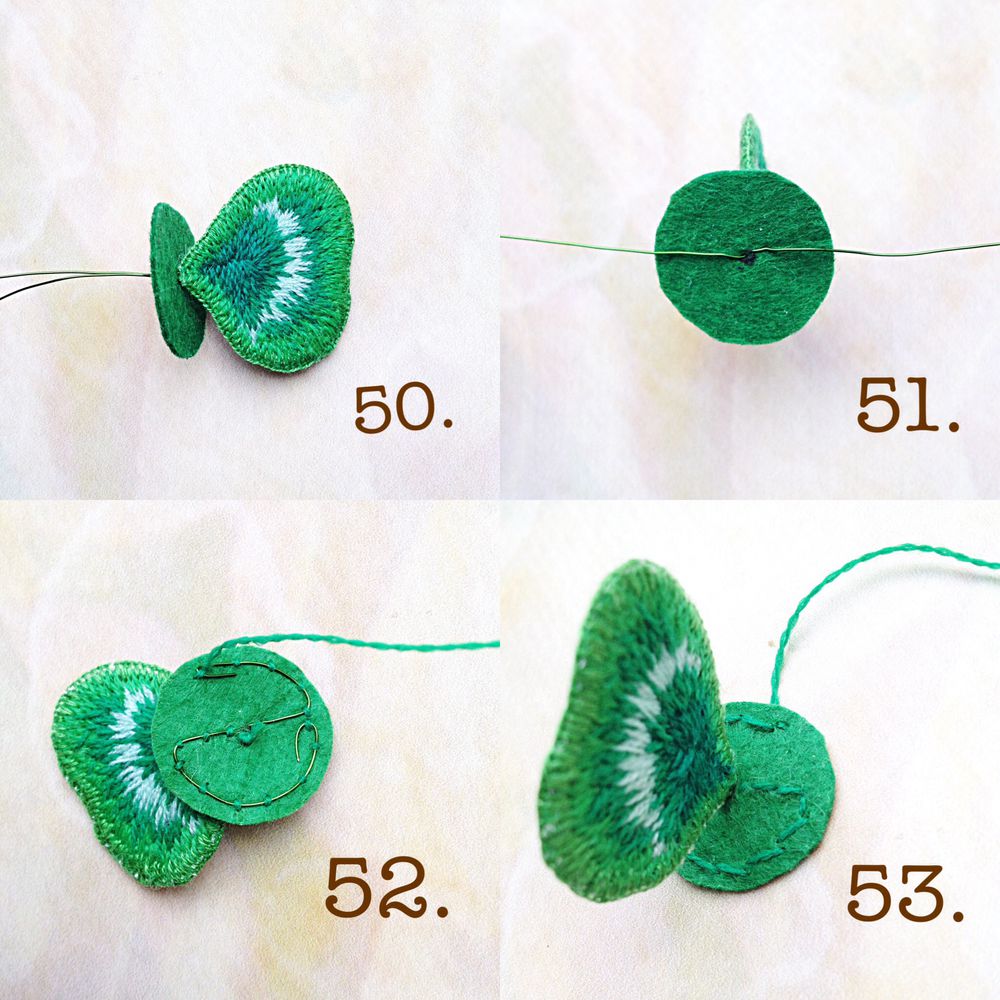
50. Take the second felt circle. Pierces the middle of the hole and insert the wire ends from the first leaf to stop.
51. unbent wire antennae.
52.nitkami color of felt sewn wire. Required Fold the tip of the wire loop.
53. The view from the front side of the felt circle.
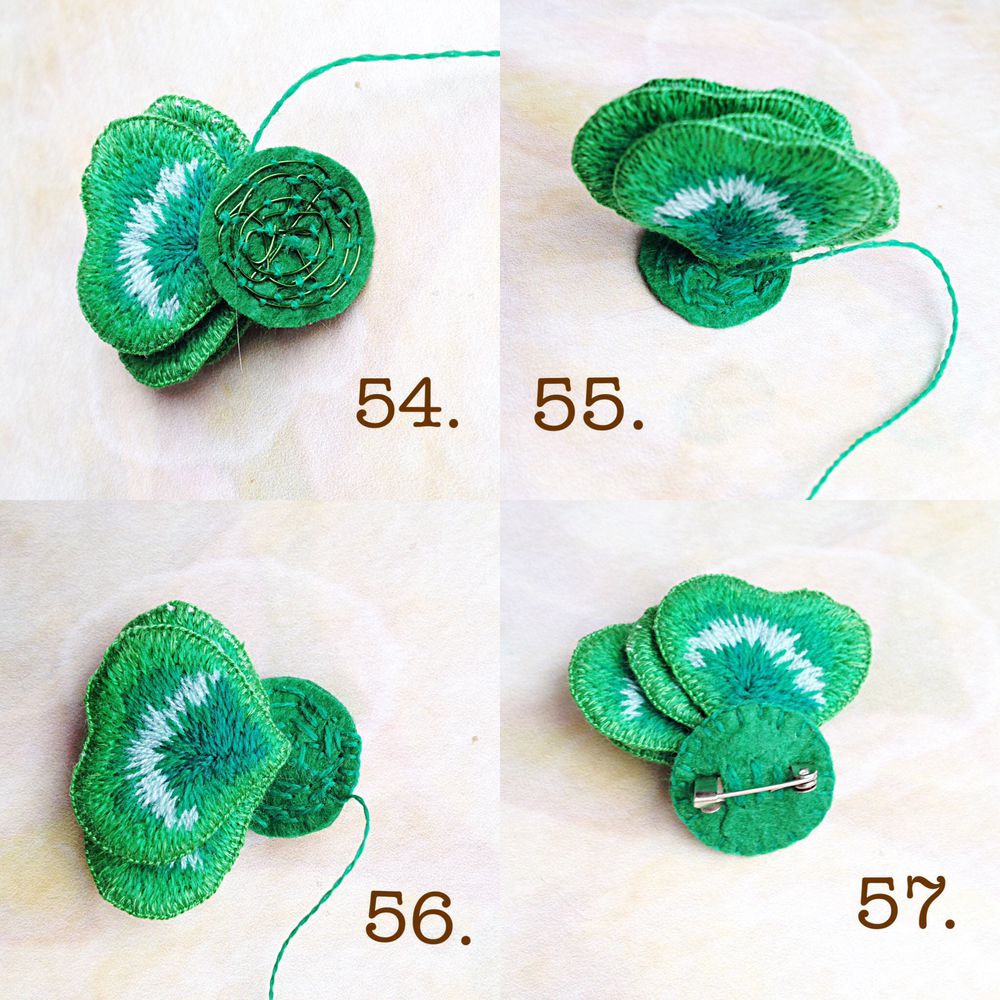
54. secure all the leaves and all the ends of the wire.
55. The view from the front side. You can leave and so, and you can embroider the felt circle further. For example, the French knots.
56. Take the second circle with a buckle. You can drop into the center of the adhesive. I use the glue gun. And you can not stick at all. A loop seam is sewn over the edge of one circle to another.
57. The underside of the brooch with buckle.
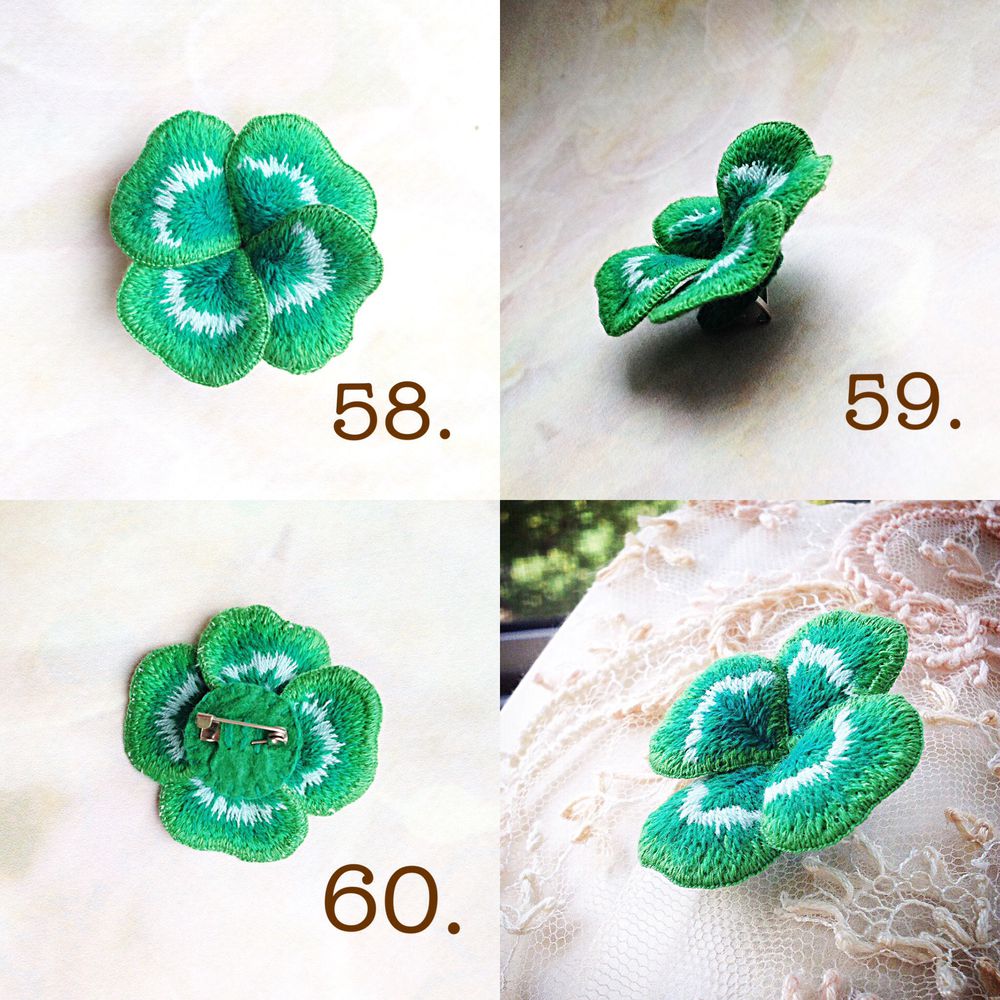
58 59.Raspravlyaem folds and leaves to your liking.
60. Wrong side brooches.
Done! Be creative, try.
Thank you for attention.
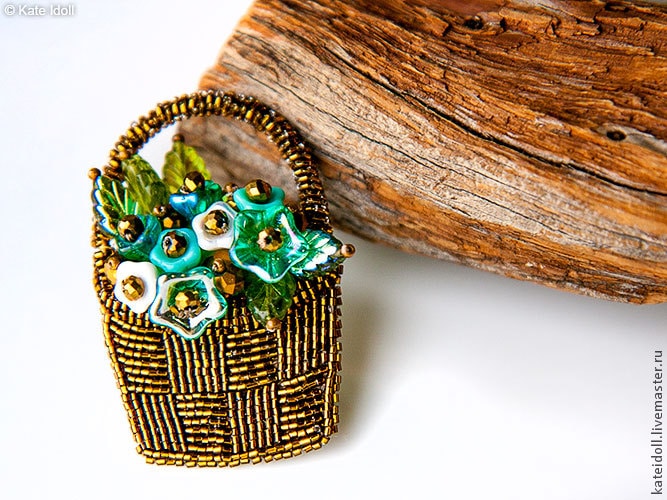
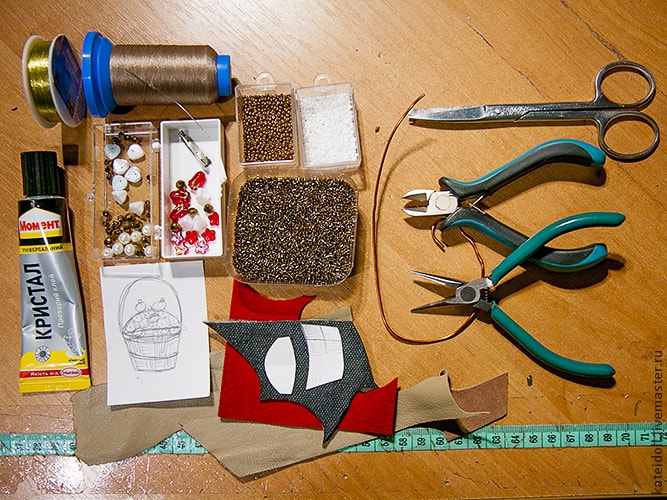
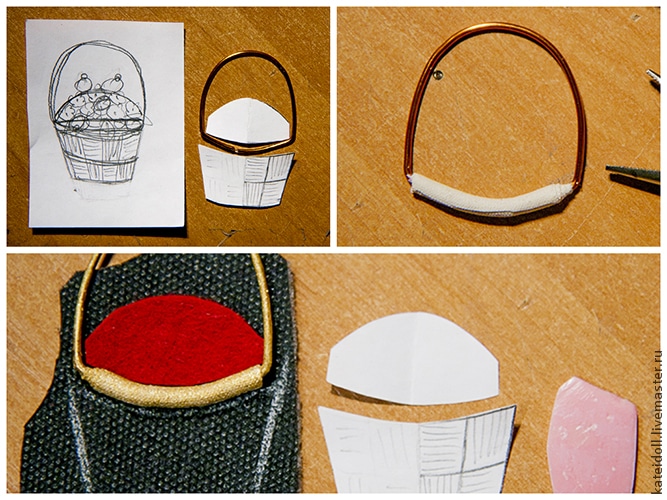 Sheathe small beads basket handle, starting from the bottom corner ledge surround is obtained
Sheathe small beads basket handle, starting from the bottom corner ledge surround is obtained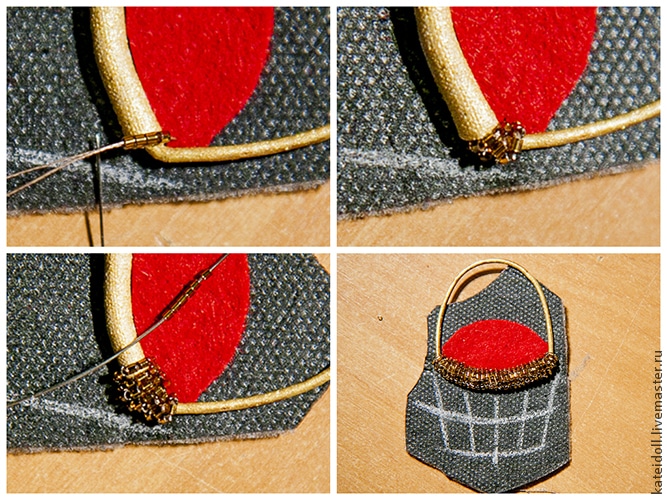
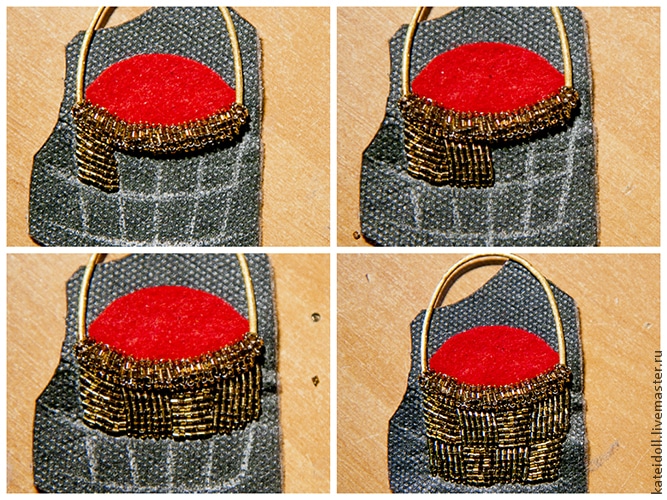 Now fill the basket leaves, flowers and crystal beads
Now fill the basket leaves, flowers and crystal beads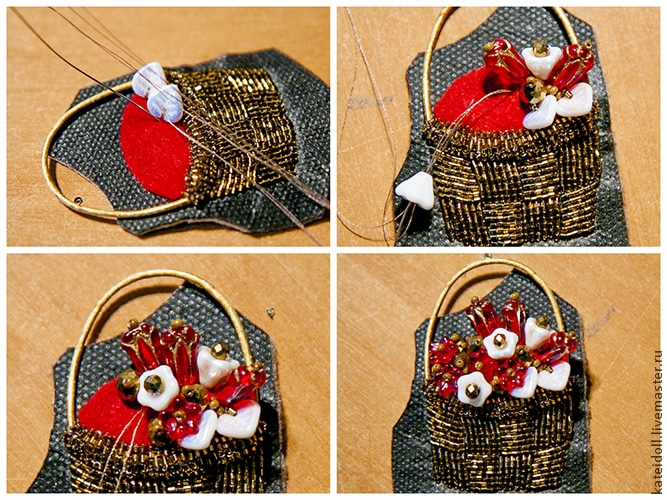 Carefully cut off the excess felt. Sticking a piece of cardboard inside out – for rigidity.
Carefully cut off the excess felt. Sticking a piece of cardboard inside out – for rigidity.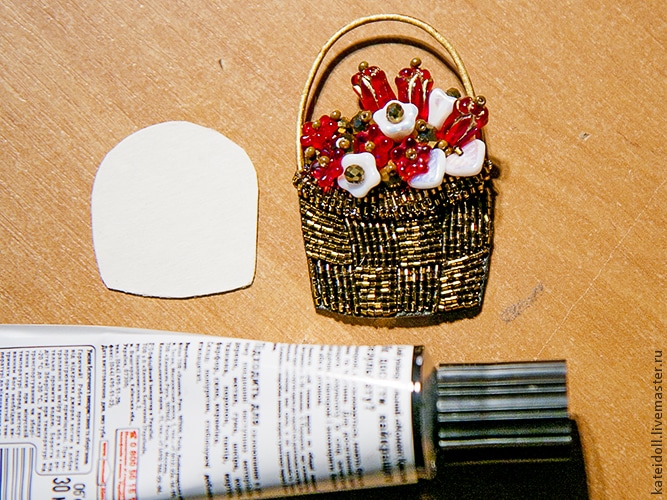
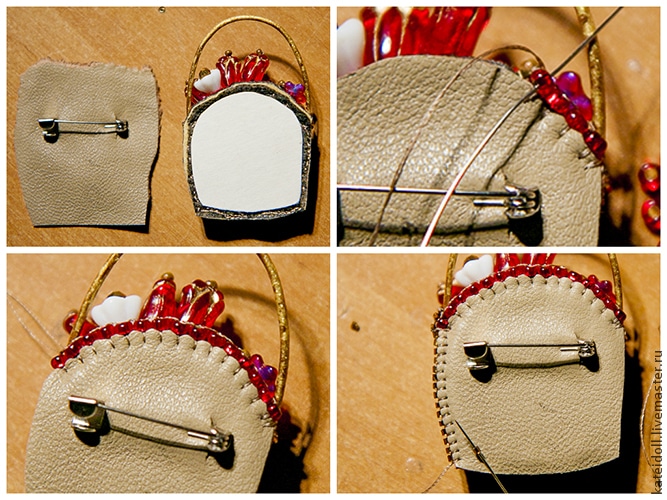

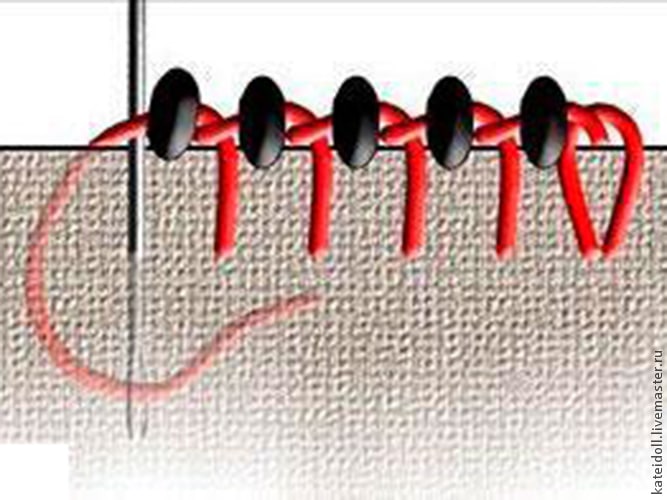 Between embroidery and edge I stayed clearance. To close it, I’m doing another series of beads around the embroidery.
Between embroidery and edge I stayed clearance. To close it, I’m doing another series of beads around the embroidery.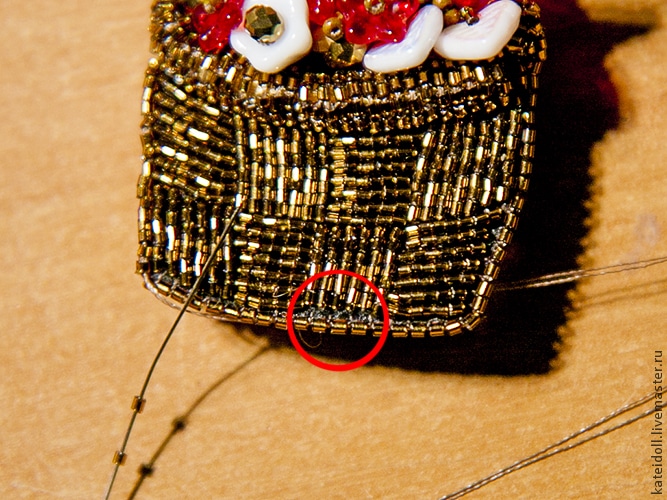 Now go to the decor of the handle. To do this, attach a length of thin wire in the corner of the pen close to the embroidery, dial the wire beads and wrap the handle.
Now go to the decor of the handle. To do this, attach a length of thin wire in the corner of the pen close to the embroidery, dial the wire beads and wrap the handle.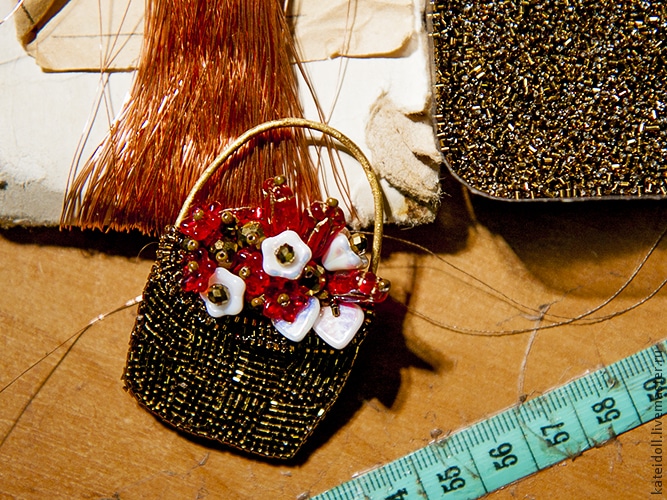
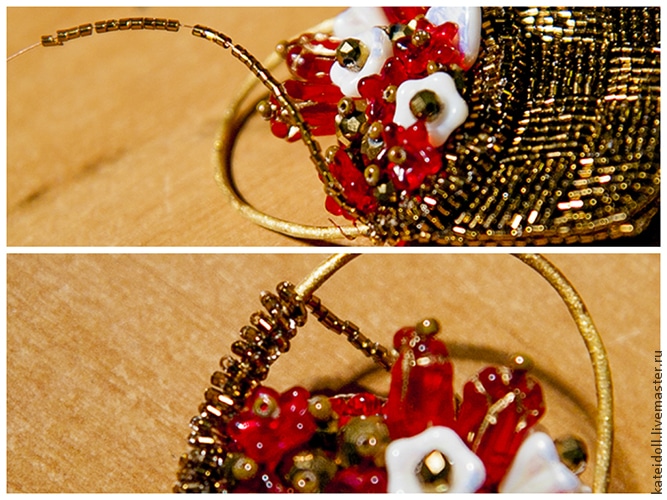 And the final touch – add a few leaves on top.
And the final touch – add a few leaves on top.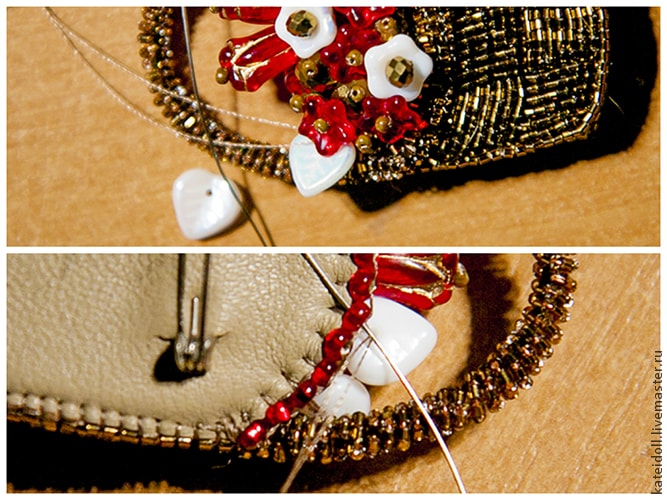 Brooch ready.
Brooch ready.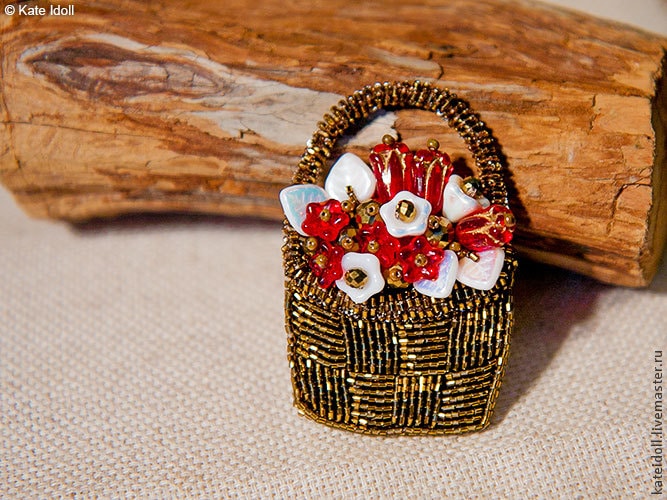
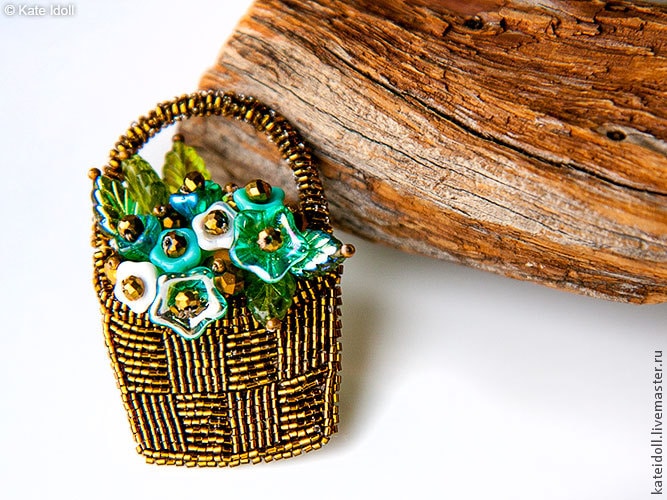
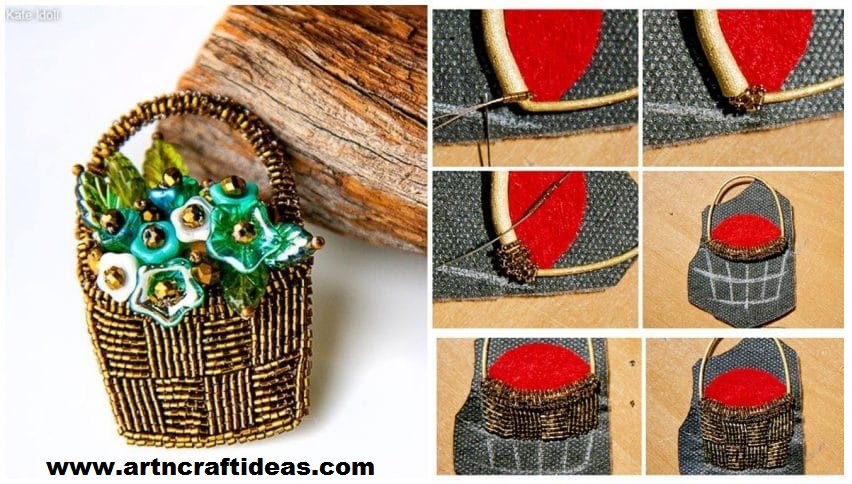
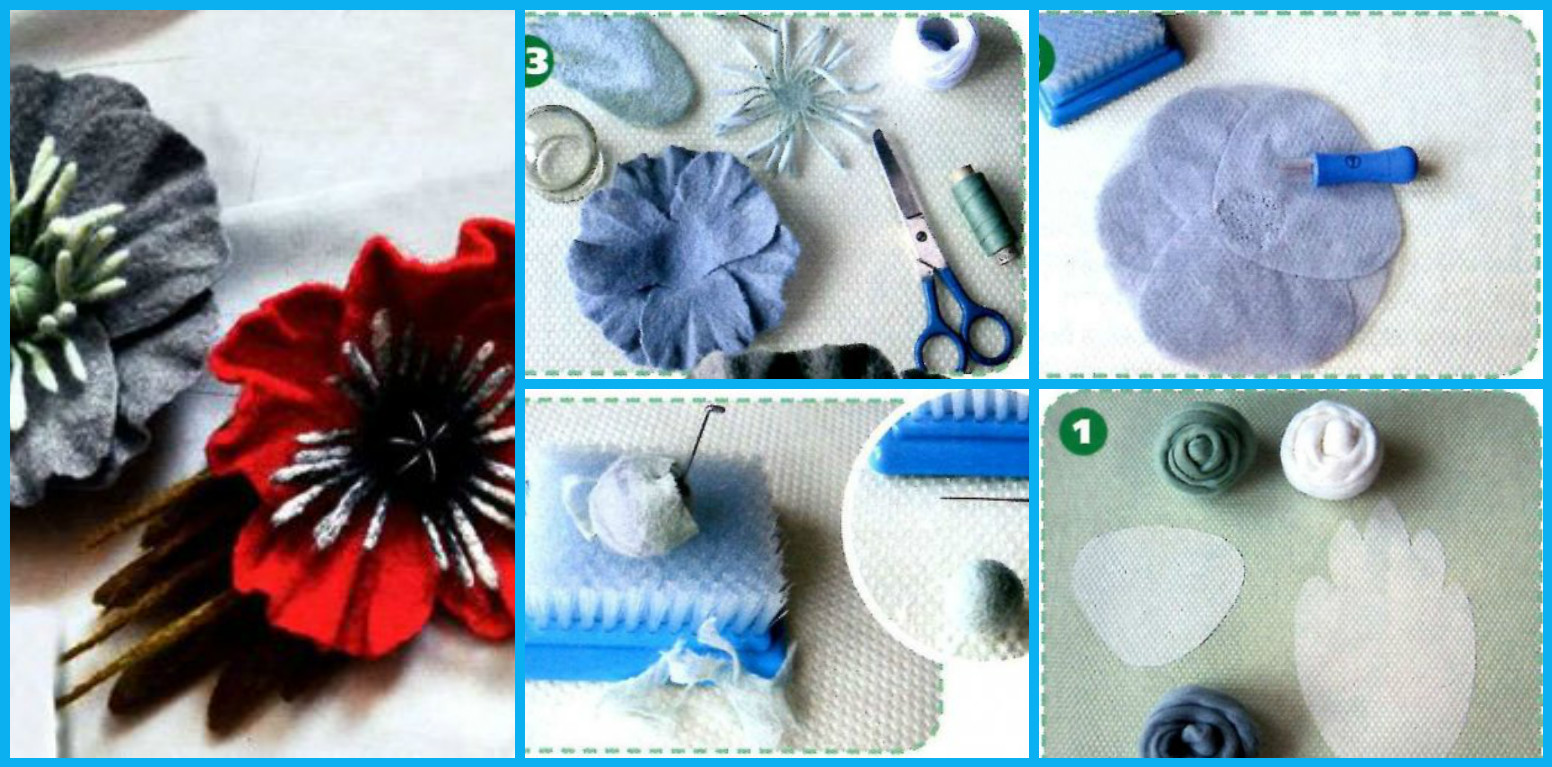
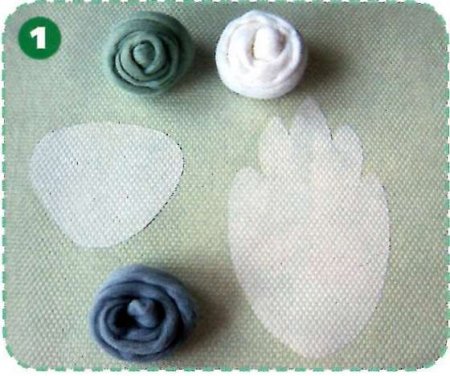 Separate from the skeins of wool strands corresponding color and place across back sheet so that the tip of the thick strands lying on the edge of the pattern. For stamens, hair lay thick on the edge of tips arbitrary circle.
Separate from the skeins of wool strands corresponding color and place across back sheet so that the tip of the thick strands lying on the edge of the pattern. For stamens, hair lay thick on the edge of tips arbitrary circle.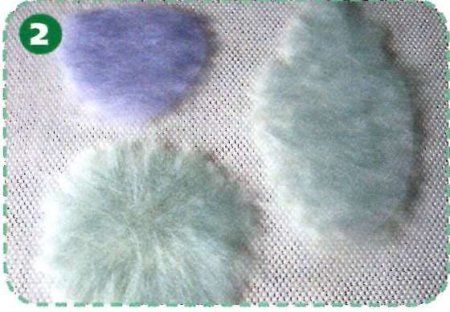 Lay longitudinal row as the previous one. Leaf decorate white wool. Circle for the stamens as making strands of white wool, folded in half.
Lay longitudinal row as the previous one. Leaf decorate white wool. Circle for the stamens as making strands of white wool, folded in half.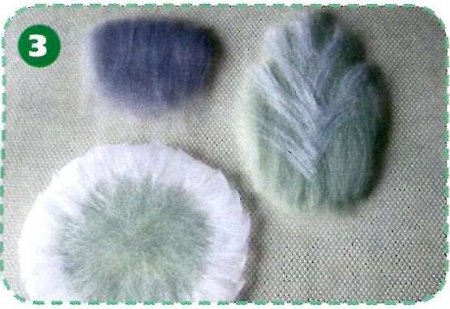 Cover layout nylon fabric and soak with soapy water. Grind elements without effort, occasionally lifting the net to her, not wool.
Cover layout nylon fabric and soak with soapy water. Grind elements without effort, occasionally lifting the net to her, not wool.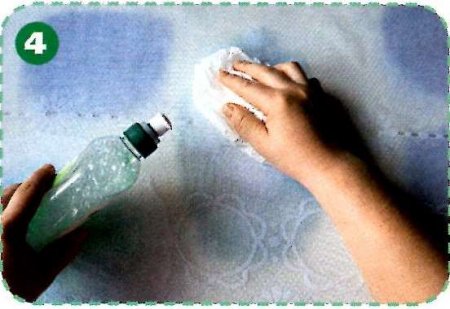 Turn the layout and grind the other side. Before you turn the future, stamens, white bend on the circle edge, thereby thickening the tips of stamens.
Turn the layout and grind the other side. Before you turn the future, stamens, white bend on the circle edge, thereby thickening the tips of stamens.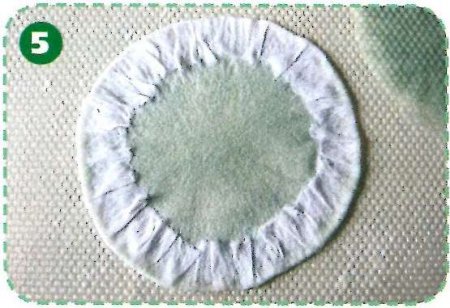 Wool flower details turn to the right side and apply the pattern on top of the film. Trim protruding edge elements.
Wool flower details turn to the right side and apply the pattern on top of the film. Trim protruding edge elements.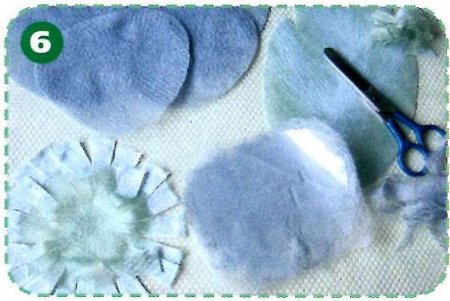 Place the petals in the shape of a circle. Use blanks from films -2 circles with a diameter of 21 cm with a hole in the middle of 4.5 cm. On the same lap evenly spread out the petals, the second cover them. As such, the flower is easy to pick up during operation and turn.
Place the petals in the shape of a circle. Use blanks from films -2 circles with a diameter of 21 cm with a hole in the middle of 4.5 cm. On the same lap evenly spread out the petals, the second cover them. As such, the flower is easy to pick up during operation and turn.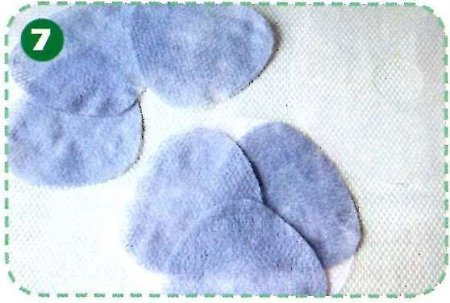 Place the flower on the brush for felting central part and pierce it with a needle applicator to both sides, turning several times. In the center of the flower petals are interconnected.
Place the flower on the brush for felting central part and pierce it with a needle applicator to both sides, turning several times. In the center of the flower petals are interconnected.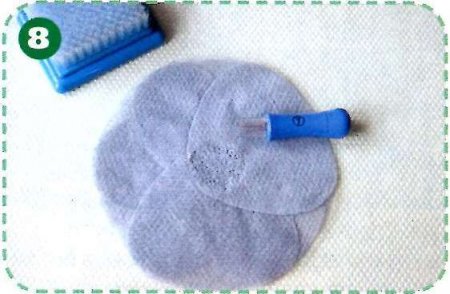 Fold the dry wool waste into a ball and pierce it Felting needle, smoothing out the form, and then moisturize and take a ride on the bubble film to seal.
Fold the dry wool waste into a ball and pierce it Felting needle, smoothing out the form, and then moisturize and take a ride on the bubble film to seal.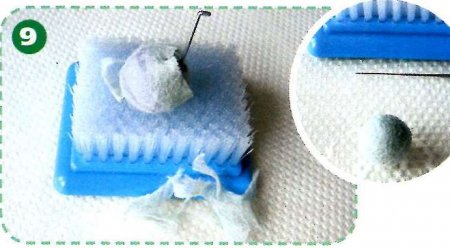 Make the circle of stamens cuts towards the center. Fold the strip along the stamens and gently Roll the fingers on the bubble film, holding the base of the strip, in order to avoid rupture. Then go ahead stamens in the hands, smoothing, and tips.
Make the circle of stamens cuts towards the center. Fold the strip along the stamens and gently Roll the fingers on the bubble film, holding the base of the strip, in order to avoid rupture. Then go ahead stamens in the hands, smoothing, and tips.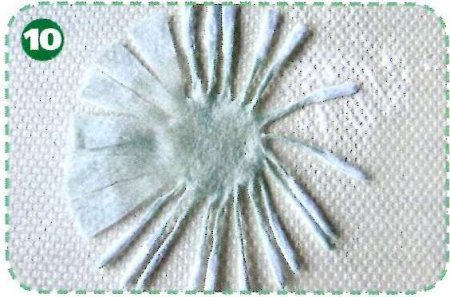 To prevent damage to the trimmed edge, flower wrinkle in his hands, turning the petals inside. Periodically disclose poppy petals flatten, moistening them if necessary. Also matted in the hands of a leaf. Ready to be felt elastic, all the elements will fall by 40%.
To prevent damage to the trimmed edge, flower wrinkle in his hands, turning the petals inside. Periodically disclose poppy petals flatten, moistening them if necessary. Also matted in the hands of a leaf. Ready to be felt elastic, all the elements will fall by 40%.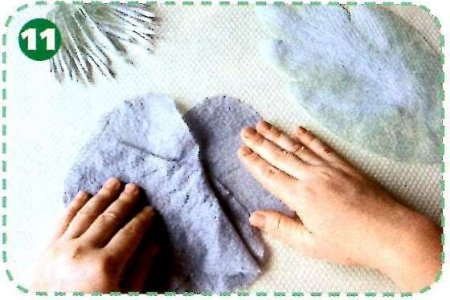 Rinse the stringy parts of the flower in the water. Corrugation – a flower with the help of a suitable size jar.
Rinse the stringy parts of the flower in the water. Corrugation – a flower with the help of a suitable size jar.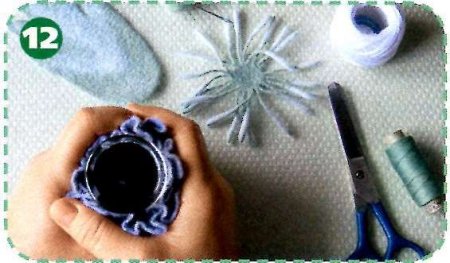 Leaf and flower dry in the expanded form, the stamens slightly prim logo and domes dry on the needle.
Leaf and flower dry in the expanded form, the stamens slightly prim logo and domes dry on the needle.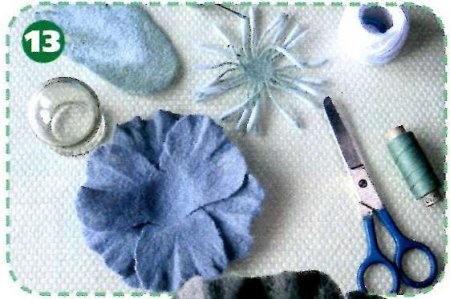 Sew seam hiding elements of the flower on the back of the stitch pin.
Sew seam hiding elements of the flower on the back of the stitch pin.